Body length: 6–18 mm.
Eyes: eye interommatidial setaeseta:
a sclerotized hair-like projection of the cuticle
present, eye deeply emarginateemarginate:
notched at the margin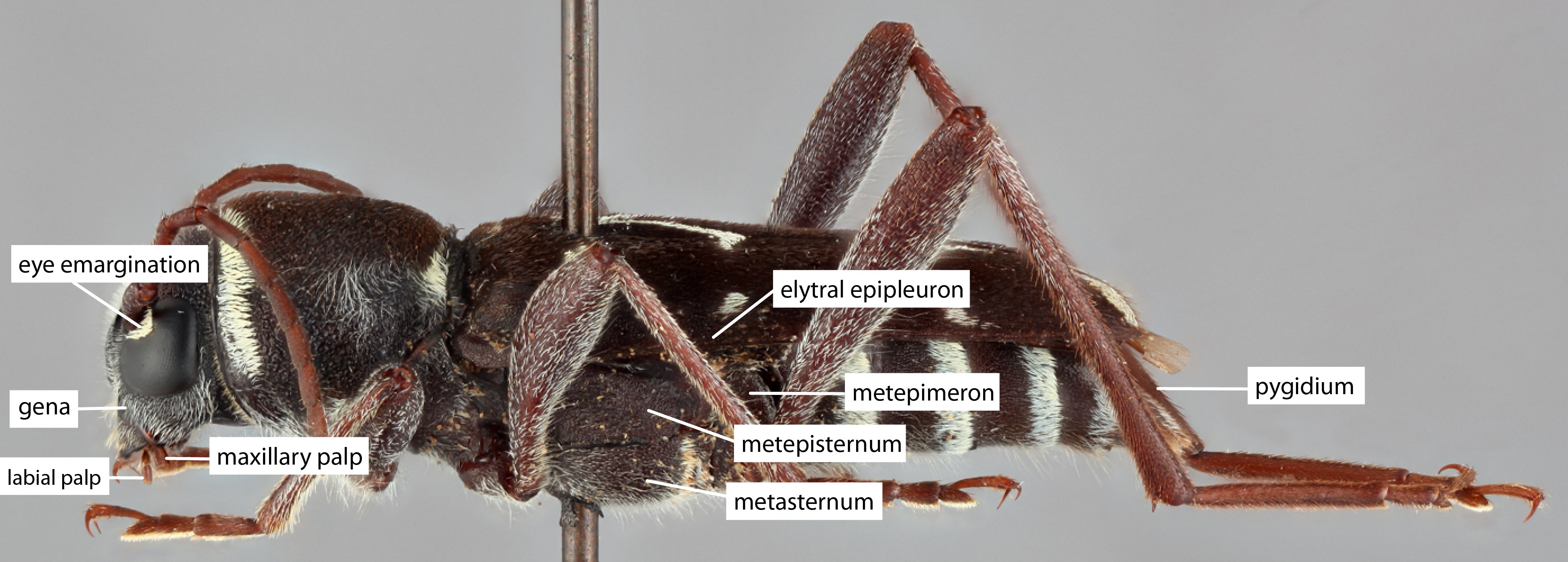 > half width, eye ommatidial density coarse.
> half width, eye ommatidial density coarse.
Antennaeantenna:
in larval and adult insects, paired segmented appendages, borne one on each side of the head, functioning as sense organs and bearing a large number of sensilla
: antennal length reaches between basebase:
the part of any appendage or structure that is nearest the body
and end of elytraelytron:
the leathery forewing of beetles, serving as a covering for the hind wings, commonly meeting opposite elytron in a straight line down the middle of the dorsum in repose
or reaching/surpassing end of body, antennal flagellar segments elongateelongate:
much longer than wide
, scapescape:
the first proximal segment of the antenna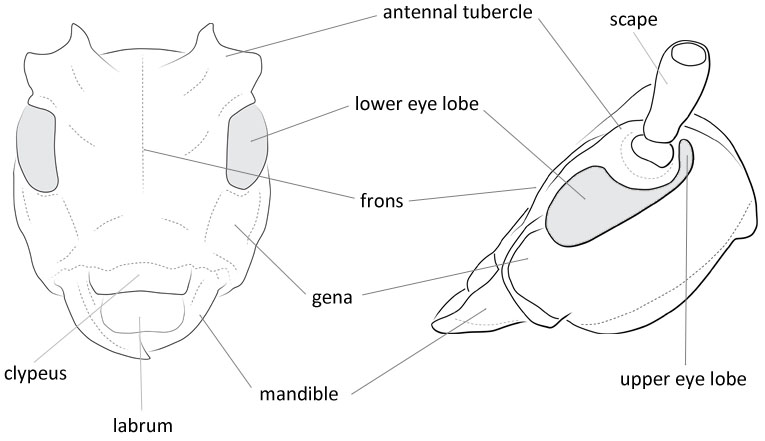 smooth/punctate at apexapex:
smooth/punctate at apexapex:
end of any structure distad to the base
, antennal scapescape:
the first proximal segment of the antenna ≥ segment 3.
≥ segment 3.
Pronotumpronotum:
the upper and dorsal part of the prothorax
: pronotumpronotum:
the upper and dorsal part of the prothorax
shape transversetransverse:
broader than long
or subquadratesubquadrate:
not quite a square
, pronotumpronotum:
the upper and dorsal part of the prothorax
lateral armature absent.
Prosternum: prosternal processprosternal process:
a posterior extension of the prosternum between the coxae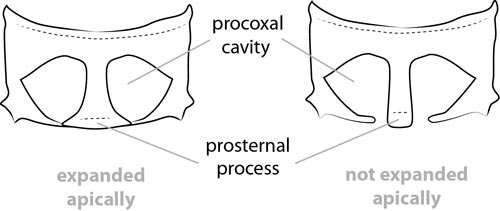 dilated at apexapex:
dilated at apexapex:
end of any structure distad to the base
, procoxal cavities open posteriorly.
Elytraelytron:
the leathery forewing of beetles, serving as a covering for the hind wings, commonly meeting opposite elytron in a straight line down the middle of the dorsum in repose
: elytral length reaching or close to end of abdomen, elytral apicesapex:
end of any structure distad to the base
rounded or truncatetruncate:
cut off squarely at the tip
or with tooth or spinespine:
a protuberance with an acute (sharp) distal end
, elytral color black, brown, yellow, reddish, or orange, elytral color pattern present or absent.
Legs: visible tarsomerestarsomere:
subdivision or article of the tarsus, usually numbering from two to five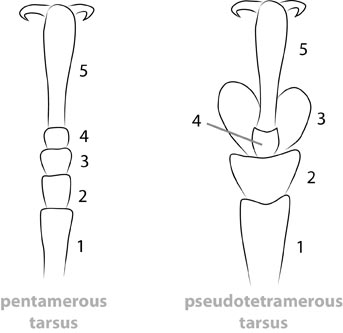 : 4, femora clavateclavate:
: 4, femora clavateclavate:
thickening gradually toward the tip
, protibial spursprotibial spur:
sclerotized spine(s) located at the distal tibia; can be single, double, or absent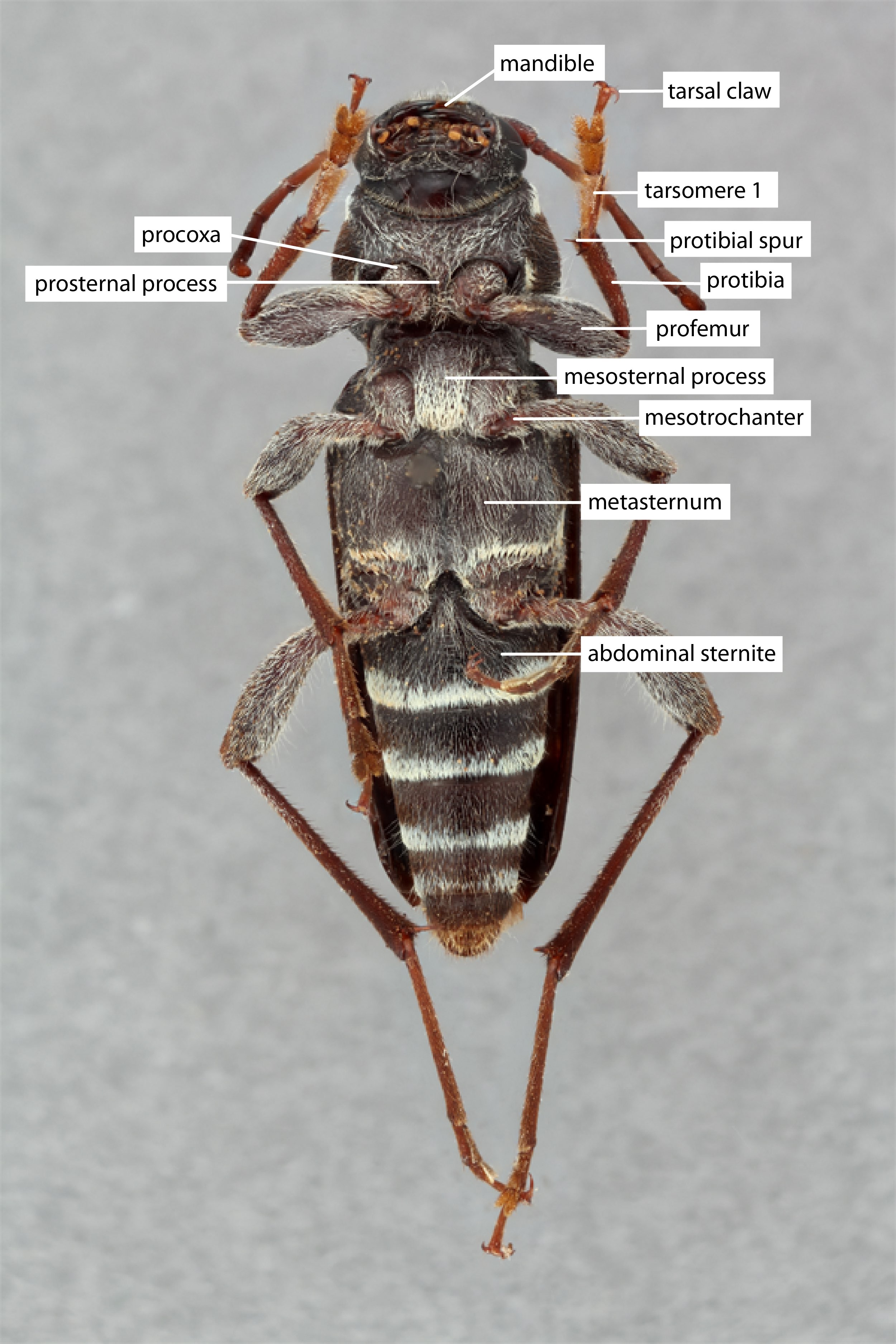 : 2, tarsal clawstarsal claw:
: 2, tarsal clawstarsal claw:
usually paired claws of the pretarsus, at the distal end of the leg simple.
simple.
Trinophylum, Stenygrinum, Stenodryas, Oebarina
Distinguished from other similar members of tribe Callidiopini by antennomereantennomere:
a subunit of the antenna, including the scape, pedicel, and flagellomeres
3 longer or = to scapescape:
the first proximal segment of the antenna , antennomereantennomere:
, antennomereantennomere:
a subunit of the antenna, including the scape, pedicel, and flagellomeres
4 < scapescape:
the first proximal segment of the antenna , and pronotumpronotum:
, and pronotumpronotum:
the upper and dorsal part of the prothorax
subquadratesubquadrate:
not quite a square
often with spots of dense setaeseta:
a sclerotized hair-like projection of the cuticle
. Oebarina has a heavily punctatepunctate:
set with fine, impressed points or punctures appearing as pin-pricks
pronotum and femora more slender. Similar looking Hesperophanini species have slender femora.
Indomalaya, Australasian, Palearctic (Asia), Afrotropical, introduced Neotropical
broadleaf trees
Three subgenera: Ceresium 166 sp.; Ceresiellum 3 spp.; Paraceresium 1 sp. C. (Ceresium) unicolor is most commonly intercepted.
Diatomocephala Thomson, 1864Thomson, 1864:
Thomson J. 1864–65. Systema cerambycidarum ou exposé de tous les genres compris dans la famille des célrambycides et familles limitrophes. H. Dessain, Liége, 578 pp. [1864: pp. 1–352; 1865: 353–578; Also published in Mémoires de la Société Royale des Sciences de Liége 19 [1866]: 1–578]. [for Ceresium]
Raphidera Perroud, 1855 [for Ceresium]
Subgenus Ceresium Newman, 1842
Subgenus Ceresiellum Gressitt, 1956
Subgenus Paraceresium Matsushita, 1932